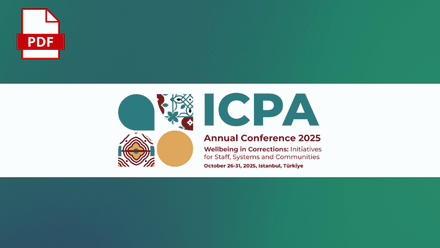Advancing Corrections Journal: Call for Papers for Issue #16
_________________________________________
The ICPA believes that development of a professional and humane corrections should be grounded in evidence. But evidence is of little value unless it is understood and put into action. Our semi-annual Advancing Corrections Journal (ACJ) is intended to fill the need for researchers to speak more clearly to practitioners and practitioners to speak in a more evidence-informed way to their colleagues. ACJ provides a forum for both researchers and practitioners from a wide range of disciplines (criminal justice, education, psychology, sociology, political science, economics, public health, and social work) to publish papers that examine issues from a unique, interdisciplinary and global perspective.
Authors are welcomed to submit papers for one of three sections of the Journal:
• Featured Research Articles
• Views and Reviews
• Practice Innovation in Corrections
ACJ Edition 16: “Reforming Corrections Through Technology”
Corrections are undergoing a fundamental transformation. Increasingly, technologies of various forms, though especially digital technologies, are permeating the way that justice involved individuals are experiencing incarceration or community supervision. Technology is determining how we make key decisions affecting these individuals, how we monitor their behaviour, design the delivery of interventions, provide access to new forms of educational, vocational or leisure and recreational involvements, and shape our response to their health and well-being concerns. Technology is helping connect those in custody with the outside world and helping support and guide those under supervision to access a range of community resources. In many ways, because of the pace and reach of technology, both service delivery, and the cardinal aim of corrections to maintain safety and security, can become more efficient and less costly, and in some instances, perhaps even more effective.
There is a promise that technology in corrections can create more humane environments rather than more intrusive or oppressive ones, that it can help make correctional work more rewarding rather than less necessary, and that it can give correctional leaders new opportunities to design a more cost-effective correctional process, especially in terms of providing meaningful support for successful reintegration and resettlement. In brief, technology is undoubtedly creating a revolution of innovation in corrections and whether we embrace it enthusiastically, or welcome it only cautiously, there is no denying that we should strive to study, learn from and adjust our design and implementation of new technology with respect for both research and practice-informed evidence.
But there is perhaps an even more underlying imperative than simply focusing on technology as an instrumental means to improve correctional practice. Technology presents corrections an opportunity for broad-based reform and reflection on its key aims. If it is indeed true that ‘you can judge a society by how it treats its prisoners’, then corrections clearly has some responsibility to help close the digital divide rather than widen it. Corrections needs to accept and anticipate the digital transformation of the world around us, give individuals under our care reasonable access and exposure to that technology and prepare them to face the new digital world we all have to contend with. Corrections in that sense needs to change not just through technology but because of it.
This 16th Edition of ACJ wishes to capture the range of ways that are already being applied, or only beginning to be developed, for Reforming Corrections Through Technology.
We want to explore the variety of technologies that are impinging on correctional operations and the design of settings, services, treatments, trainings and assessment and monitoring methods. In particular, we want to highlight examples of successful approaches, including where public-private partnerships and other collaborative efforts have overcome obstacles and inertia in implementation.
- We welcome contributions that reflect on the prospect of correctional reform through technology and which informs recommendations for practice, policy and research:
- Reasoned and evidence-based arguments regarding the potential benefits, but also the possible disadvantages and risks in adopting particular technologies;
- Empirically informed and critical discussions of how digital should be addressed in policy that can support correctional reform and benefit its users, the organisations, and the broader community;
- Insights and critical reflections on how the role of corrections is changing and adapting to the digital world;
- Reasoned and evidence-based arguments regarding the impact direct and indirect changes in society are having on corrections and our responsibility to alter current practices for a new world where digital has become (for some) the new normal;
- Insights and critical reflections on the implementation of digital technologies and lessons learned in digitalization of correctional practice, in either custody or community settings;
- Empirical explorations of how justice involved individuals and/or correctional staff and managers have responded, adapted and perceived the introduction of digital or other new technologies;
- Insights into the design and delivery of rehabilitation focused correctional programming, educational or vocational training of our justice involved individuals, and training of our correctional workforce;
- Examples of how digital technologies have changed the design of our supervised or carceral environments and how the evolution of virtual possibilities can alter the way we think about the fashioning of those environments;
- Discussion of key challenges and obstacles that need to be overcome in introducing new technologies (including in bringing new technologies to the developing world);
- Exploring the impact of digital inequality and examples of how new technology can be used for supporting vulnerable or disadvantaged and marginalized populations;
- Discussions of the potential (and the potential pitfalls) of emerging AI and machine-learning technologies both for information management and risk assessment in corrections, and for application of new security mechanisms for monitoring and control in prison environments;
- And finally, perspectives regarding what research is needed to move us further forward in reforming corrections through technology.

